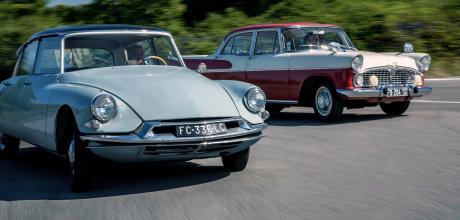1958 Citroen DS 19 vs. 1960 Simca Vedette Chambord
In the 1950s, automobiles were not only a means to display one's success but also a reflection of one's character. Buyers of the Citroën DS were known for their avant-garde taste and willingness to take risks, while those who favored the Simca Vedette were drawn to American influences and conservative engineering.
By Olivier Bernis and Jérôme Fombelle.
Photos: Benjamin Asket — Virage Agency
Outward Signs of Wealth
THE ROYAL ROAD
SIMCA STARTING FROM €7,500
CITROEN STARTING FROM €18,000
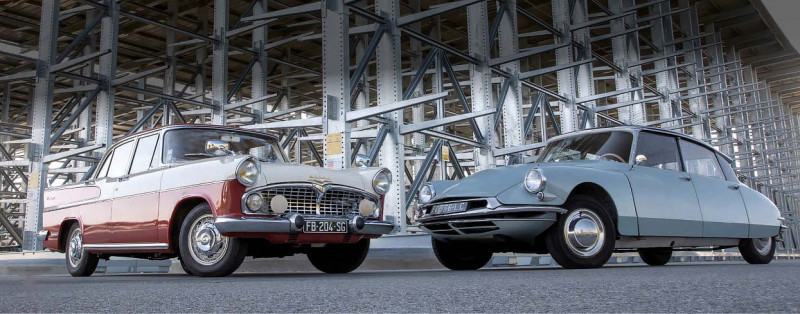
A decade after the end of World War II, the preferences of French car enthusiasts had undergone a radical transformation. No longer were they interested in purely utilitarian, austere, and unappealing automobiles. Economic growth was on the rise, and desires replaced mere needs. Concurrently, the end of shortages in raw materials and the influx of hard currency into the manufacturers' coffers rekindled their appetite.
For Citroën, it was high time to replace the venerable Traction, which, while still technologically relevant, had a silhouette that seemed too «pre-war.»
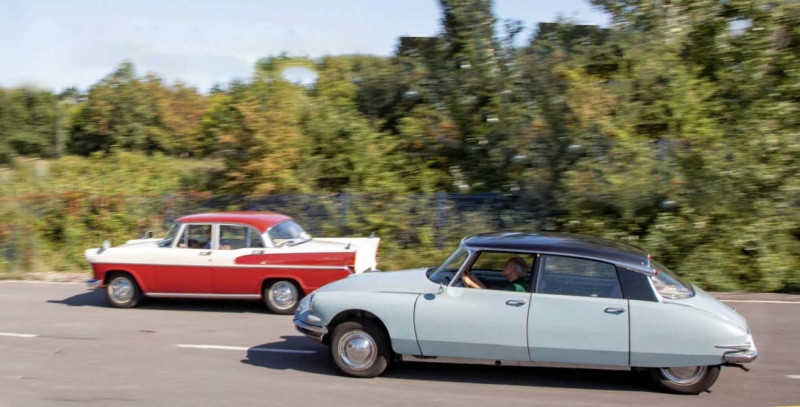
After testing its hydropneumatic suspensions on the latest models, Citroën was ready to incorporate them into a car brimming with technical innovations. Power steering, brakes, gearbox – almost everything was hydraulically controlled. The only (significant) drawback was the continued use of the engine from the Traction's final models. While the press of the time did not hesitate to criticize this decision (rightly so), it also had to acknowledge Citroën's lead over the competition.
Simca, on the other hand, had a different mindset. Fueled by the success of the Aronde, the company acquired the French branch of the giant Ford and, in the process, gained access to the almost completed project of the second generation of the Vedette. This allowed them to introduce a high-end car powered by a V8 engine, a rarity in the French market. It was a very traditional setup, with a three-speed gearbox, but it stroked the ego and pleased the owner's ears. The meticulous decoration of the Vedette solidified its image as a car worthy of crossing the Atlantic. While the Frégate struggled with never-ending reliability issues, the DS and Vedette divided the growing customer base of large sedan enthusiasts, which we would now call «executive cars.»
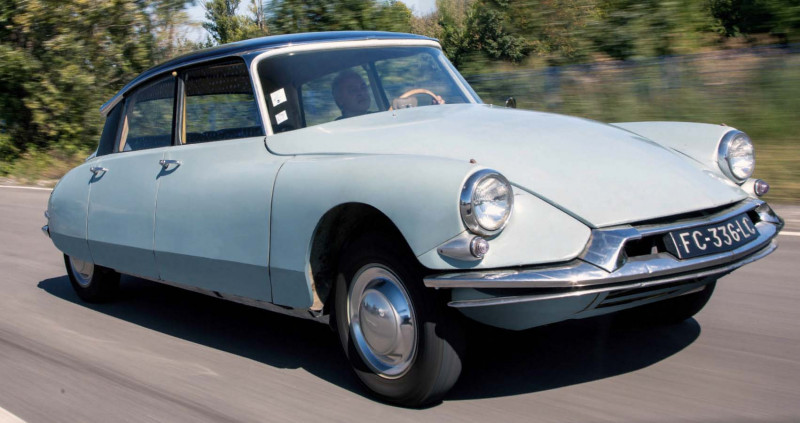
Engineer vs. Salesperson
To be completely transparent, our two journalists had a challenging time deciding which cars to choose. Each of these cars, though vastly different, possesses a unique charm. Olivier, our esteemed editor, ultimately succumbed to a 1959 Citroën DS 19, an original example imported from the United States and remarkably well-preserved. Meanwhile, Jérôme momentarily put aside his love for technical prowess and fell for the allure of advertisements praising the Simca Vedette. Not just any Vedette, but a chic 1960 Chambord version. Streamlined design and advanced technology on one side, American style and classic underpinnings on the other. Each is poised to convince the other of their superiority.
CITROËN DS 19
In case Jérôme needs a reminder, despite his low tactics to defend his Simca Chambord, the DS is undoubtedly the most iconic of French cars throughout the ages. It's one of the most famous cars in the world for its stylistic and technological audacity. The star of the 1955 Paris Auto Show, it not only overshadowed its predecessor, the Traction, but also outshone other French productions of the time, like the Peugeot 403 (unveiled at the Grand Palais the same year), Simca Aronde, or Renault Frégate, whose round lines paled in comparison to the avant-garde style of the DS, driven by the brilliant Italian designer Flaminio Bertoni.
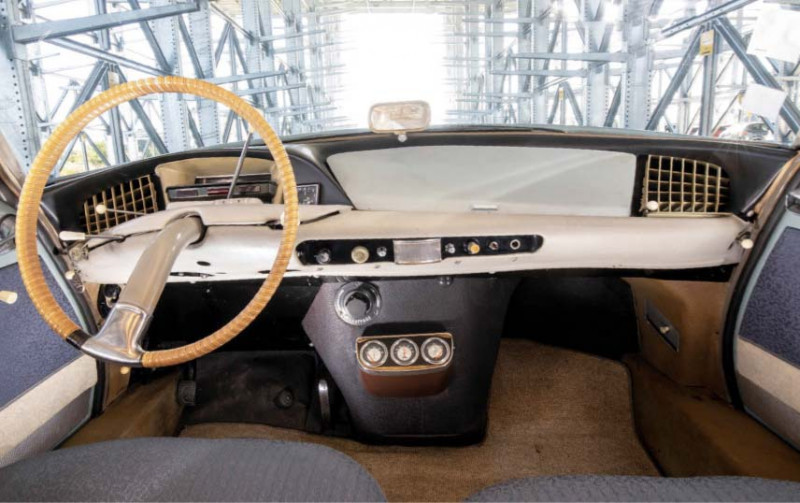
Beyond the visual impact that stunned at its launch, the DS left a lasting mark on its era by revolutionizing the automobile industry with numerous innovations, including disc brakes (the first production car in the world to feature them on the front wheels) and the hydropneumatic suspension that controlled the clutch, steering, and fabulous ride. So, with great pleasure, I choose to defend this historical monument against Jérôme's flashy «Americanized» Simca. To spice up this duel, the DS 19 I must drive began its career in the land of Uncle Sam. First registered in Minnesota in July 1959, this beautiful American car has now made its way back to France, where it gracefully cruises along the roads of Ardèche, much to my delight.

If my last «official» encounter with a DS was behind the wheel of a luxurious and powerful 1973 DS23 Pallas IE version, I'm rediscovering the distinctive ambiance of the early models as I settle into the plush seat of this charming «Blue Cloud» 19 with an «Oriental Blue» roof. Quite an experience! While some peculiarities (the presence of gauges, ammeter, oil pressure, and water temperature, a speedometer marked in miles) indicate that I'm in a U.S. version, the atmosphere of French DS cars from the 1950s is palpable. Before starting, I need to turn the small ignition advance lever left before turning it all the way right when I begin moving. Not very intuitive, but you get used to it. To start the engine, once the ignition key is turned, you simply push the small gear lever behind the steering wheel to the left. This same lever is used to shift up and down through the four gears. Shifting gears is a simple hand gesture, no clutch pedal required, as effortless as using today's paddle shifters or automated manual transmissions. The first gear has a very low ratio (unfortunately non-synchronized), primarily used for «takeoff» toward the windshield. To change gears, you need to release the accelerator, select the gear with the lever (2nd toward you, 3rd and 4th to the right), and then reapply the throttle. Again, this maneuver requires some practice and finesse in wrist movement. While there is a relatively significant gap between 2nd and 3rd gears, the latter can be easily used up to 100 km/h on the speedometer without straining the engine. Beyond that, the 4th gear, with its high overdrive ratio, doesn't provide any additional acceleration but proves valuable in reducing fuel consumption.
Undoubtedly Comfortable
Inherited from the Traction and refined with an aluminum head, the old 1,911 cc 4-cylinder engine isn't a powerhouse, delivering only 75 hp. However, its power is sufficient at low revs. While power steering offers comfortable driving, both in the city and on the highway, the braking requires a bit of learning. It's bewildering due to the tiny «mushroom» pedal and its extremely short travel, which can send your head into the windshield during the initial stops. Fortunately, its efficiency, thanks to the front disc brakes, is exceptional.
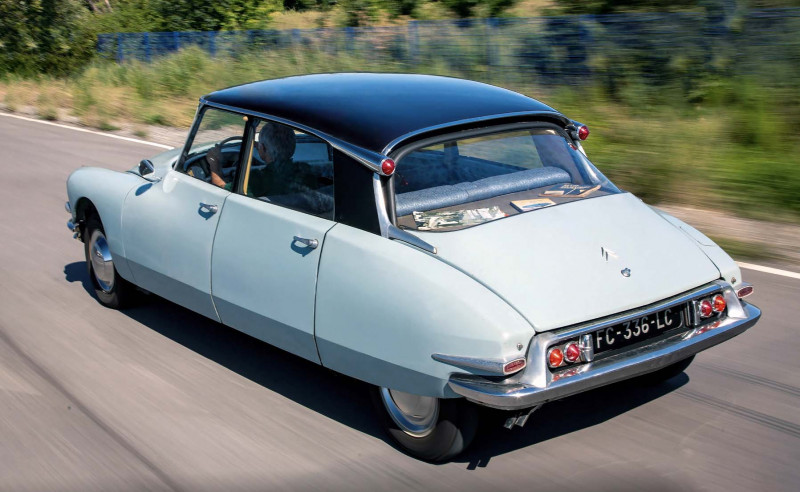
Once you've acclimated to all the somewhat puzzling operational quirks of the DS, I must admit, like the ever-grumbling Jérôme, it proves very enjoyable on all types of journeys. Enjoyable first for the driver, who benefits from ample natural light in the cabin and remarkable visibility to the front and sides, thanks to the very large windows and panoramic windshield. It's also comfortable for passengers, who can enjoy a generous wheelbase (3.12 meters between the front and rear wheels) for an incredibly comfortable ride on the accommodating rear bench. The remarkable hydropneumatic suspension works like magic to smooth out all road irregularities. I experienced this once again on our test route, where Jérôme's Chambord lost a wheel trim when passing over a speed bump, while the DS effortlessly crossed at the same speed thanks to its famous nitrogen-charged spheres.
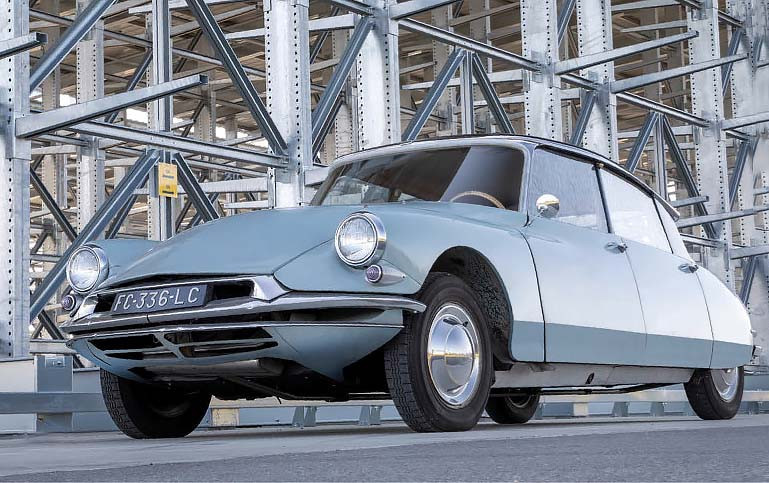
The «royal treatment» in a French family car isn't determined by a marketing designation but, of course, on the road, where the DS has always reigned supreme.
Technical specifications for the 1958 Citroën DS 19
- Engine: Inline 4-cylinder
- Displacement: 1,911 cm³
- Fiscal Horsepower: 11 CV
- Maximum Power: 75 horsepower (SAE) at 4,500 rpm
- Maximum Torque: 137 Nm at 3,000 rpm
- Fuel System: Twin-carburetor Zenith Stromberg
- Transmission: Front-wheel drive, 4-speed hydraulic control gearbox
- Brakes: Front disc brakes, rear drum brakes
- Tires: 165 R 400
- Dimensions: Length × Width × Height: 4.80 × 1.79 × 1.47 meters
- Weight: 1,125 kg
- Top Speed: 144 km/h
- Acceleration (0 to 1000 meters): 42.4 seconds
- Average Fuel Consumption: 12.2 liters per 100 kilometers
- Fuel Tank Capacity: 65 liters
- Trunk Capacity: 500 dm³
These specifications provide an overview of the key technical details of the Citroën DS 19. The Citroën DS was known for its innovative hydraulic suspension system and other advanced features, making it a classic and iconic car.
SIMCA VEDETTE CHAMBORD
Let's address the thorny issue of choice right away. When we talk about high-end cars, why did I succumb to the very American classicism of the Vedette instead of the avant-garde DS? Don't think that, when you love classics, you automatically reject all technology. But for me, every technological advancement must adhere to two fundamental principles. Firstly, it must work. It's all well and good to reinvent the wheel, but if it's flat… Secondly, it must be tailored to its audience. You can always give a knife to a chicken, but there's a slim chance it will use it. The Citroën DS simply disregards these two principles. So, I leave it to Olivier to pore over the owner's manual for hours, to find the starter control, which, unlike most cars, doesn't operate with a key. To play with the manual ignition advance, which only this old Traction engine requires fine-tuning. To wait for the body to rise before hitting the road, a ritual reserved only for the rare hydropneumatic suspensions. To delicately apply pressure to the «mushroom» brake pedal, a skill unique to Citroën drivers. And to wipe off excessive hydraulic fluid from a system that leaks more than it should. I prefer to content myself with a car that's as classic as they come, but offers the same royal comfort. Sure, it may not have much visual originality, but at least, I can take the wheel without having to revise my entire driving training, which, I admit, is a bit outdated.
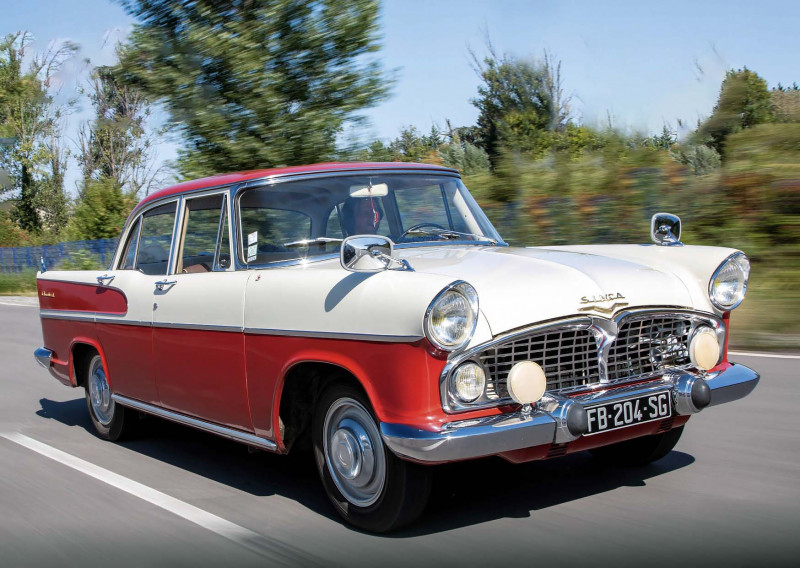
Three pedals on the floor, a gear lever behind the steering wheel, and an ignition key to the right of the column. I'm on familiar ground. A turn of the key wakes up a mechanism that perfectly complements the chrome, two-tone color scheme, and small rear fins that exude an American feel. The displacement of the V8 Aquilon is modest, but it produces a satisfying growl. Here, there's no concealing an ancient pre-war engine beneath a designer outfit like the DS. No, the feathers match the song. Of course, the technology isn't cutting-edge, with a central camshaft and, above all, side-valves. However, the performance is good, even better than the DS. The imposing Vedette accelerates with enthusiasm in a rather short, non-synchronized first gear. The second gear does most of the work. The engine provides excellent low-end torque and maintains a pleasant high-end stretch. The third gear is mainly for traveling quickly, up to 140 km/h at most, and lowering the noise level, though it remains very acceptable. Tradition has its merits. The supple suspension and plush comfort invite peaceful travel. No need for capricious and incontinent hydropneumatic devices to handle bumps, holes, and speed bumps with barely any need to lift off the accelerator. Especially when it comes to the chassis, Simca did things right with a monocoque body and McPherson front suspension. And when I sit down, I can close the door without fear of it getting stuck, given how much the body has lowered. In the back, the ambiance is the same. There's legroom, abundant light, and impressive elbow room. You can even travel with six people! Yes, the front bench can accommodate a driver and two passengers, as the floor, completely devoid of a handbrake, gear lever, and other center console components, is free of any leg obstruction. Most importantly, the trunk is huge. Much larger than what six people would need for a three-week camping trip. Even the spare tire, securely placed in the left fender, doesn't obstruct loading while remaining easily accessible. A remarkable feat that modern car designers should take notes from. A talented traveler, prioritizing roads over highways, the Vedette is perfect for leisurely drives but also behaves well in traffic, especially in its post-1957 second version with enlarged brakes. And what style! If the DS is a star at gatherings, the Vedette is a true goddess on the road. And if I had to hit the road right now, I wouldn't trade my Chambord for Olivier's DS, not for a second.
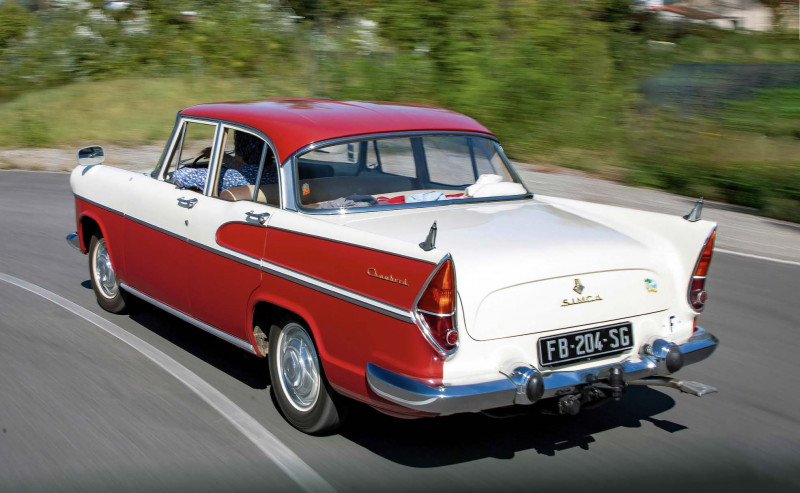
Technical specifications for the 1961 Simca Vedette Chambord
- Engine: V8, 16 valves
- Displacement: 2,351 cm³
- Fiscal Horsepower: 13 CV
- Maximum Power: 80 horsepower (SAE) at 4,400 rpm
- Maximum Torque: 152 Nm at 2,200 rpm
- Fuel System: Twin-carburetor
- Transmission: Rear-wheel drive, 3-speed manual gearbox
- Brakes: Front and rear drum brakes
- Tires: 165 R13 on both front and rear
- Dimensions: Length × Width × Height: 4.50 × 1.75 × 1.48 meters
- Weight: 1,150 kg
- Top Speed: 139 km/h
- Acceleration (0 to 1000 meters): 41 seconds
- Average Fuel Consumption: 12 liters per 100 kilometers
- Fuel Tank Capacity: 60 liters
- Trunk Capacity: 800 dm³
These specifications provide an overview of the key technical details of the Simca Vedette Chambord, which was produced between 1954 and 1961. It was known for its V8 engine and classic American styling.
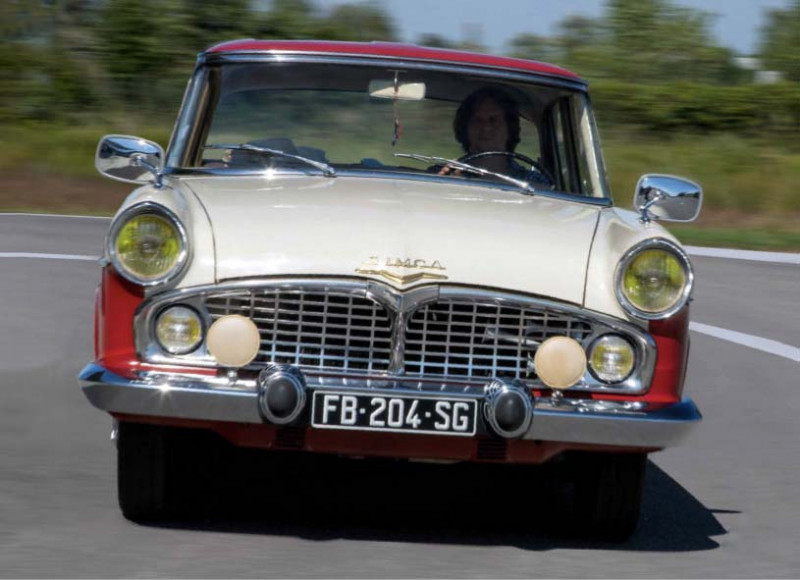
It appears you've provided a detailed comparison between the Citroën DS 19 and the Simca Vedette Chambord. Here's a summary of the key points:
Advantages of the Simca Vedette Chambord:
- Distinctive V8 engine sound.
- Large trunk space.
- Classic American-style design.
- User-friendly driving experience.
- Comfortable rear bench with an impressive width.
- Complete instrumentation, including speed, temperature, fuel level, clock, and trip meter.
- Accessible spare wheel location in the trunk.
- Elegantly placed fuel cap behind the license plate support.
- The V8 engine provides a unique driving experience with a pleasant sound.
- Reliable when well-maintained.
- Retro wing mirrors for unique styling.
Advantages of the Citroën DS 19:
- Technological innovation with hydropneumatic suspension and avant-garde design.
- Excellent visibility with a panoramic windshield.
- Spacious and comfortable interior.
- While the DS may not have the same engine power as the Chambord, it excels in terms of acceleration and top speed.
- Historically solid and reliable engines, though it had some hydraulic system issues in its early years.
Disadvantages of the Simca Vedette Chambord:
- Limited availability of spare parts.
- Equipped with a 3-speed gearbox, which may limit versatility.
- Brakes could have more stopping power.
- Issues with cooling and ignition in the V8 engine.
- Limited spare parts dealerships compared to the Citroën DS.
- Retro wing mirrors affect visibility.
Disadvantages of the Citroën DS 19:
- Limited availability of parts.
- The 4-speed gearbox could be more responsive.
- Requires meticulous maintenance, especially for the hydropneumatic suspension.
Performance Comparison:
The Citroën DS excels in acceleration, while the Chambord outperforms it in top speed.
The DS has a more advanced suspension system.
The Chambord has a powerful V8 engine, which is enjoyable but may be less reliable.
Comfort and Space:
The DS offers exceptional comfort, especially with its hydropneumatic suspension.
The Chambord provides impressive interior space and rear bench comfort.
Trunk Space:
The Chambord offers a significantly larger trunk space with easy spare tire access.
In Summary:
Both cars have their unique attributes, and the choice should depend on individual preferences.
The Citroën DS 19 impresses with its advanced technology but requires meticulous maintenance.
The Simca Vedette Chambord offers a classic, easy-to-drive experience with a unique V8 engine and an American-style look but may pose challenges in finding spare parts.
It's clear that both cars have their own character and strengths, so the choice between them would depend on personal priorities and intended use.
Here's a summary of the comparison between the Citroën DS 19 and the Simca Vedette Chambord, specifically regarding comfort, trunk space, pricing, insurance, and parts availability:
Comfort:
The Citroën DS 19 offers unparalleled comfort with its hydropneumatic suspension and spacious interior.
The Simca Vedette Chambord is also comfortable, with impressive elbow room, although it doesn't match the DS in terms of suspension comfort.
Trunk Space:
The Simca Vedette Chambord wins in terms of trunk space, offering 60% more volume compared to the DS. It also has easily accessible spare tire compartments.
Pricing:
The Citroën DS 19 tends to be more expensive, whether for restoration, revision, or being road-ready.
The Simca Vedette Chambord is generally more affordable across the board.
Insurance:
Insurance costs for the Citroën DS 19 are somewhat higher than those for the Simca Vedette Chambord. This cost varies depending on the type of coverage chosen, with the DS being slightly more expensive.
Price of Parts:
Some parts for the Citroën DS 19 are more expensive than their counterparts for the Simca Vedette Chambord.
Availability of parts for the DS may be slightly better than for the Simca Vedette.
Overall Ratings:
- Both cars have their merits and are worthy of consideration.
- The Citroën DS 19 is beloved for its technological innovation and comfort but requires diligent maintenance.
- The Simca Vedette Chambord is easier to drive and maintains a classic American aesthetic, offering more storage space and passenger capacity, although it may be more challenging to find replacement parts.
- In the end, the choice between these two cars depends on individual preferences and priorities, considering factors such as maintenance skills, budget, and intended use.


